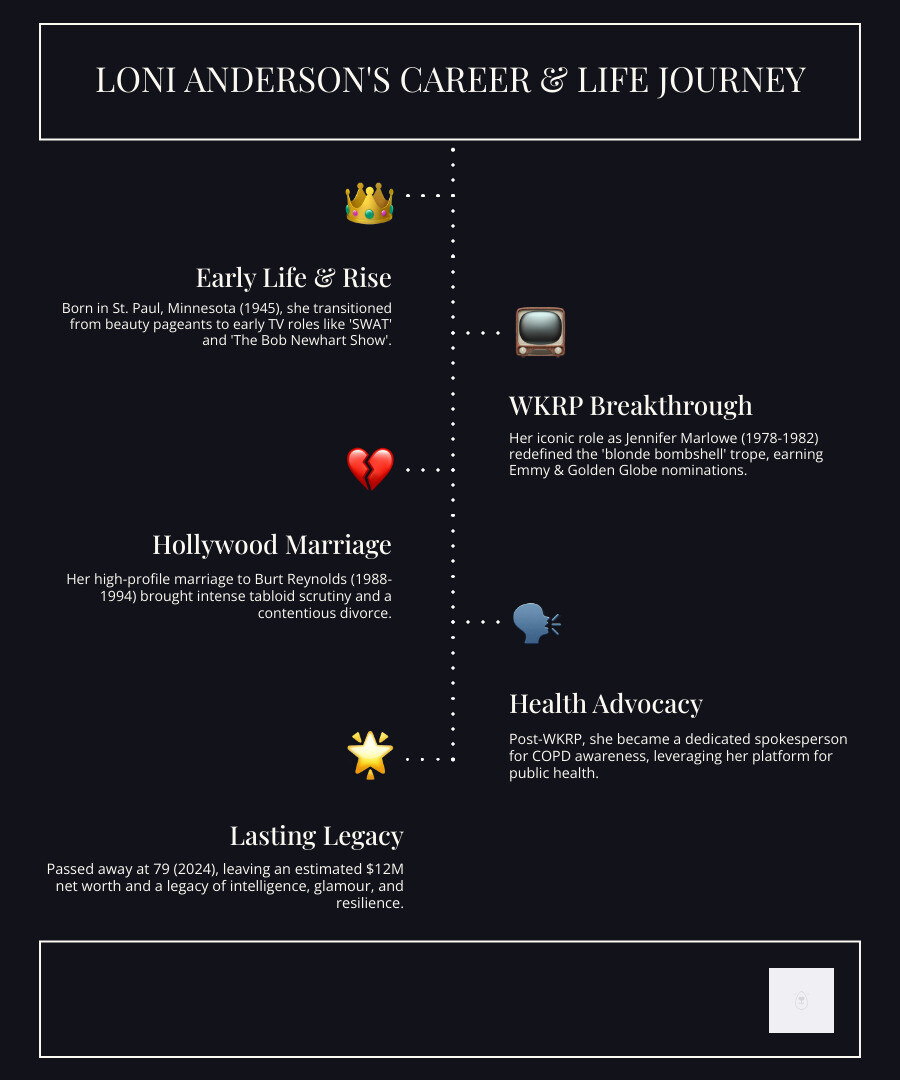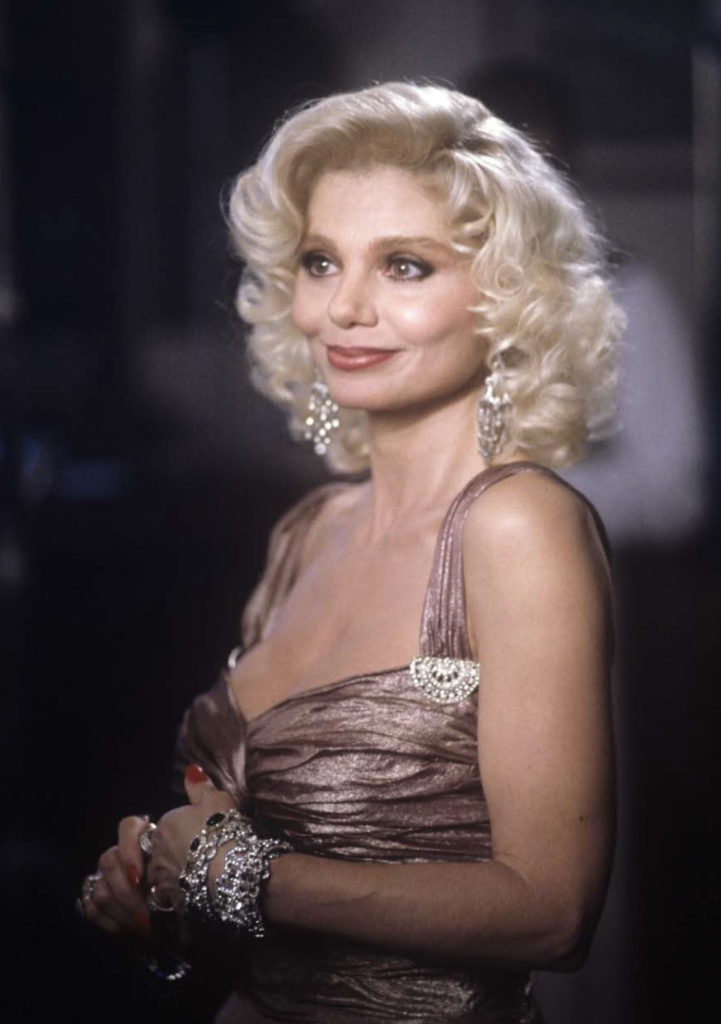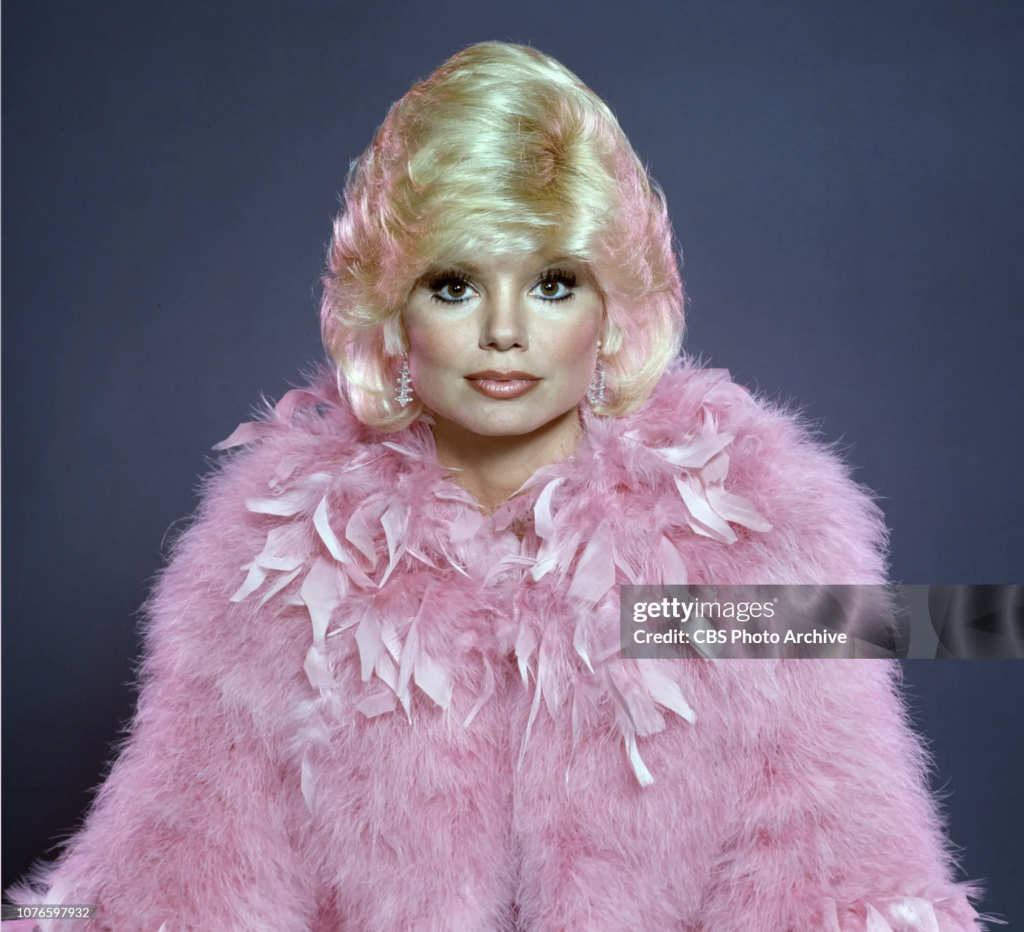
Why Loni Anderson Remains a Television Icon

Photo – David Crotty/ PMC
Loni Anderson was an American actress who captured hearts as the intelligent receptionist Jennifer Marlowe on the hit CBS sitcom “WKRP in Cincinnati” from 1978 to 1982. Born on August 5, 1945, in St. Paul, Minnesota, Anderson passed away on August 3, 2025, at age 79 from an acute prolonged illness.
Key Facts About Loni Anderson:
- Most Famous Role: Jennifer Marlowe on “WKRP in Cincinnati”
- Awards: 2 Emmy nominations, 3 Golden Globe nominations
- Personal Life: Married 4 times, including to Burt Reynolds (1988-1994)
- Net Worth: Estimated $12 million at time of death
- Legacy: Broke the “dumb blonde” stereotype on television
- Advocacy: Spokesperson for COPD awareness
Anderson’s career spanned decades, but she’s best remembered for refusing to play Jennifer Marlowe as a typical “dumb blonde.” Instead, she worked with show creator Hugh Wilson to make her character the smartest person in the room. This choice earned her critical acclaim and helped redefine how blonde actresses could be portrayed on television.
Her marriage to Burt Reynolds from 1988 to 1994 kept her in the tabloid spotlight, sometimes overshadowing her professional achievements. The couple adopted son Quinton together, but their divorce became one of Hollywood’s most contentious, with Reynolds ordered to pay $15,000 monthly in spousal support.
Beyond acting, Anderson became a passionate advocate for lung health after both her parents suffered from COPD. She used her platform to raise awareness about the disease through various health organizations.
As someone who has covered New York’s entertainment scene for over four decades, I’ve witnessed how Loni Anderson’s influence on television comedy continues to resonate with audiences and industry professionals alike. Having worked closely with celebrities navigating both triumph and controversy, I understand the unique pressures Anderson faced balancing stardom with personal challenges.

Easy Loni Anderson glossary:
From Minnesota Beauty Queen to Hollywood Star

Every Hollywood legend starts somewhere, and for Loni Anderson, that somewhere was the wholesome heartland of St. Paul, Minnesota. Born Loni Kaye Anderson on August 5, 1945, she embodied the classic American dream – a small-town girl with big-city aspirations.
Her natural beauty and poise were evident early on. After graduating from high school in 1963, Loni Anderson made her mark as the 1964 Miss Minnesota runner-up. This wasn’t just about looking pretty in a crown – beauty pageants in those days taught young women confidence, public speaking, and stage presence. Skills that would serve her well in the years ahead.
Like so many aspiring actors, Loni Anderson cut her teeth on television guest spots throughout the 1970s. She appeared on popular shows like S.W.A.T. and The Bob Newhart Show, proving she could handle both drama and comedy with equal skill. These weren’t starring roles, but they were crucial stepping stones that helped her build industry connections and hone her craft.
The move to Hollywood wasn’t easy, especially for a single mother from the Midwest. But Loni Anderson was determined to make it work, one audition at a time.
The Foundation of a Lasting Career
What set Loni Anderson apart wasn’t just her striking looks – it was her commitment to the craft. She took early acting classes and continued her studies at the University of Minnesota, treating acting as a profession that required real skill and preparation.
The juggling act between motherhood and career was particularly challenging in the 1970s, when working mothers faced far more scrutiny than they do today. Loni Anderson managed this delicate balance with grace, proving that ambition and family life didn’t have to be mutually exclusive.
Her strategy was smart: she built her reputation methodically through guest appearances on popular 70s shows. Each role, whether on Police Woman or The Love Boat, added another credit to her resume and another connection to her growing network in the industry.
By the late 1970s, Loni Anderson had established herself as a reliable, talented performer who could bring both beauty and brains to any role. Little did audiences in New York City and across America know that her most iconic character was just around the corner – one that would completely redefine what it meant to be a blonde bombshell on television.
The Role That Defined a Generation: Jennifer Marlowe in WKRP in Cincinnati

When we think of Loni Anderson today, one image immediately comes to mind: the brilliant and glamorous Jennifer Marlowe from WKRP in Cincinnati. This wasn’t just another TV role – it was a character that would reshape how America viewed the “blonde bombshell” archetype forever.
Jennifer Marlowe was for her time. Instead of playing the typical ditzy receptionist, Loni Anderson brought intelligence, wit, and surprising depth to the role. Her character consistently proved she was the smartest person at the fictional radio station, often solving problems that left her male colleagues scratching their heads. This clever subversion of the “dumb blonde” stereotype resonated with audiences across the country, including here in New York City, where viewers have always appreciated characters with both beauty and brains.
The critical acclaim was immediate and sustained. Loni Anderson earned two Emmy nominations for Outstanding Supporting Actress in a Comedy Series and an impressive three Golden Globe nominations during the show’s four-year run from 1978 to 1982. These weren’t just token nods – they reflected genuine recognition of her talent and the cultural impact Jennifer Marlowe was having on television.
WKRP in Cincinnati became more than just a sitcom; it was a cultural phenomenon that continues to find new audiences today. The show’s enduring popularity, particularly in sophisticated markets like New York City, speaks to its timeless humor and memorable characters.
Crafting an Intelligent Icon
Here’s where Loni Anderson’s story gets really interesting. She initially refused to take the role as originally written. The script called for a typical “dumb blonde” secretary, but Anderson saw an opportunity for something much more meaningful. She wasn’t about to waste her talent on another one-dimensional character.
Working closely with creator Hugh Wilson, Loni Anderson helped transform Jennifer Marlowe into television gold. Together, they crafted a character who was not only gorgeous but also savvy, independent, and often the most competent person in any room. Her character was ahead of its time, presenting a woman who controlled her own destiny while looking fabulous doing it.
Anderson’s commitment to her worth extended beyond character development. In the summer of 1980, she made headlines by walking out over a salary dispute. She knew her value to the show and wasn’t afraid to demand fair compensation. When the network finally agreed to her terms, she returned – but not before making a powerful statement about knowing your worth in Hollywood.
This kind of strategic positioning and brand management is something we understand well in the entertainment industry. For those interested in how proper positioning can lift a brand’s value, you can learn more about our branding services.
The Lasting Impact of Loni Anderson’s Signature Role
Loni Anderson’s awards and nominations for WKRP in Cincinnati tell the story of consistent excellence: two Emmy nominations in 1980 and 1981 for Outstanding Supporting Actress in a Comedy Series, plus Golden Globe nominations three years running from 1980 to 1982 for Best Actress in a Television Series Musical or Comedy.
These accolades placed her firmly in the TV bombshell pantheon alongside icons like Farrah Fawcett and Suzanne Somers. But Anderson carved out her own unique space – one where glamour and intelligence weren’t mutually exclusive. She became a household name that represented something new and exciting in television.
Beyond her acting prowess, Loni Anderson emerged as a genuine fashion and style icon. Jennifer Marlowe’s impeccable wardrobe became the talk of the nation, influencing fashion trends from coast to coast. Here in New York, where style matters as much as substance, Anderson’s sophisticated look resonated with viewers who appreciated her character’s perfect blend of professionalism and glamour.
The impact was lasting. Even decades later, Jennifer Marlowe remains a touchstone for how to create a character that’s both beautiful and brilliant – proving that Loni Anderson didn’t just play a role, she helped redefine what was possible for women on television.
The Tumultuous Personal Life of Loni Anderson
While Loni Anderson impressd audiences on screen, her personal life unfolded like a dramatic storyline of its own. Behind the glamorous facade lived a woman who experienced the full spectrum of love, heartbreak, and family devotion. Her romantic journey included four marriages that each brought different chapters to her life story.
Her first husband was Bruce Hasselberg, followed by Ross Bickell. Then came the marriage that would dominate headlines for years – her union with Burt Reynolds. Finally, she found lasting happiness with Bob Flick, a member of the folk group The Brothers Four, whom she married in 2008.
Loni Anderson acceptd motherhood with the same dedication she brought to her career. She had two children who became the center of her world: her daughter Deidra Hoffman and her adopted son Quinton Reynolds, whom she shared with Burt. As someone who has covered countless celebrity families in New York’s social scene, I’ve witnessed how challenging it can be to balance public demands with private family needs, and Loni Anderson steerd this with remarkable grace.
The most heart-wrenching challenge came in 2009 when her daughter Deidra was diagnosed with Multiple Sclerosis. This devastating news transformed Loni Anderson from Hollywood star to devoted caregiver. She stepped back from acting opportunities to focus on supporting her daughter through Multiple Sclerosis, proving that family always came first in her priorities.
Loni Anderson also cherished her role as grandmother to Deidra’s daughters, McKenzie and Megan Hoffman, plus two step-grandchildren from her marriage to Bob Flick. These relationships brought joy and purpose to her later years, showing a softer side that fans rarely glimpsed.
The Hollywood Super-Couple: Marriage and Divorce with Loni Anderson and Burt Reynolds
The romance between Loni Anderson and Burt Reynolds captivated America like few celebrity couples before or since. Their 1988 wedding was the stuff of Hollywood fairy tales, complete with lavish celebrations and endless media coverage. For a brief, shining moment, they seemed to embody everything glamorous about Tinseltown romance.
The couple’s decision to adopt son Quinton together only added to their picture-perfect image. Reynolds, already a major movie star, and Loni Anderson, fresh from her WKRP success, appeared to have it all. They graced red carpets from Los Angeles to New York City, where their appearances at premieres and galas always generated excitement among society watchers.
But the fairy tale crumbled quickly under intense tabloid scrutiny. What began as a celebrated union deteriorated into one of Hollywood’s most acrimonious divorces. The separation process started in 1993 and wasn’t finalized until 1994, but the public battle raged much longer.
Public accusations flew from both sides like arrows in a bitter war. Reynolds made headlines with cruel comments, famously calling Loni Anderson a “shopaholic” and making other disparaging remarks that shocked their fans. Loni Anderson fought back in her 1997 autobiography “My Life in High Heels,” revealing painful details about Reynolds’ alleged infidelities and personal struggles.
The ugly divorce that wouldn’t end dragged on for years, with financial disputes continuing long after the papers were signed. The court ordered Reynolds to pay $15,000 monthly in spousal support – equivalent to about $30,000 today – plus cover the mortgage on their Beverly Hills mansion.
This devastating period significantly impacted her public image and career. The media circus often overshadowed Loni Anderson’s professional accomplishments, forcing her to endure personal humiliation on a national stage. Having witnessed similar situations unfold in New York’s entertainment circles, I understand how damaging such public battles can be to one’s reputation and future opportunities. It’s precisely these kinds of challenges that highlight the importance of strategic crisis management PR when personal lives become public spectacles.
Legacy, Final Tributes, and Net Worth

Photo – Stefanie Keenan/PMc
When Loni Anderson passed away on August 3, 2025, just two days before her 79th birthday, Hollywood lost one of its most beloved stars. Her publicist confirmed that she died from “an acute prolonged illness,” though the specific details remained private. It was a quiet end for someone who had lived so much of her life in the public eye, yet it reflected the dignity she maintained throughout her career.
The outpouring of love from her colleagues spoke volumes about the woman behind the glamorous image. Morgan Fairchild, who had recently worked with Loni Anderson on the Lifetime movie Ladies of the ’80s: A Divas Christmas, was heartbroken. “The sweetest, most gracious lady!” she remembered. Barbara Eden shared equally touching words, calling her “a real talent, with razor smart wit and a glowing sense of humor.” But perhaps the most telling tribute came from her manager of three decades, Steve Sauer, who described her as “the ultimate working mother” who always put “family first.”
Beyond her entertainment career, Loni Anderson had become a passionate advocate for lung health awareness. After watching both her parents struggle with COPD, she dedicated herself to organizations like COPD Together and the National Lung Health Education Program. She understood the platform her fame provided and used it wisely to bring attention to important health issues. Here in New York, where so many of us have been touched by health advocacy campaigns, we deeply appreciate celebrities who use their influence for meaningful causes.
Her contributions to television went far beyond Jennifer Marlowe. She helped redefine what it meant to be a “TV blonde” and showed that intelligence and glamour could coexist beautifully. That legacy continues to inspire actresses and audiences alike.
The Financial Picture of Loni Anderson
Loni Anderson was as smart with her money as she was with her career choices. At the time of her death, her estimated net worth stood at $12 million, according to details on her net worth. This impressive figure came from her successful acting career, wise real estate investments, and the substantial divorce settlement from Burt Reynolds.
Her real estate moves were particularly shrewd. In July 2007, she sold her French-style Beverly Hills mansion for $5.7 million – quite a profit considering she’d bought it in 1994 for $2.275 million. That same year, she purchased a Sherman Oaks home for $1.9 million, which she later sold in 2015 for $2.1 million. These weren’t just homes; they were investments that showed her business acumen.
The spousal support from Reynolds also played a significant role in her financial stability. The court had ordered him to pay $15,000 monthly – roughly $30,000 in today’s money. This steady income stream, combined with her smart property investments, ensured her financial security long after her most active Hollywood years.
Her financial story mirrors her career: thoughtful, strategic, and successful. She proved that beauty and brains extended beyond the screen into real-world business decisions.
Frequently Asked Questions about Loni Anderson
What was Loni Anderson’s most iconic role?
When people think of Loni Anderson, one character immediately comes to mind: Jennifer Marlowe, the brilliant receptionist from “WKRP in Cincinnati.” This role, which ran from 1978 to 1982 on CBS, wasn’t just another TV character – it was a cultural phenomenon that redefined what it meant to be a blonde on television.
What made Jennifer Marlowe so special was how Loni Anderson refused to play her as the typical “dumb blonde” stereotype. Instead, she worked with the show’s creators to make Jennifer the smartest person in the room – a savvy businesswoman who happened to be gorgeous. This groundbreaking portrayal earned her three Golden Globe nominations and two Primetime Emmy Award nominations, recognition that speaks to both her talent and the character’s lasting impact.
Even here in New York City, where sophisticated entertainment has always been appreciated, Jennifer Marlowe remains a beloved figure. The character proved that intelligence and glamour could go hand-in-hand, a message that still resonates with audiences decades later.
What was the cause of Loni Anderson’s death?
Loni Anderson passed away on August 3, 2025, just two days before what would have been her 79th birthday. Her publicist confirmed that she died from “an acute prolonged illness,” though the specific details of her condition were kept private, respecting her family’s wishes during this difficult time.
What we do know is that Loni Anderson had long been an advocate for lung health awareness. She became particularly passionate about Chronic Obstructive Pulmonary Disease (COPD) after watching both of her parents struggle with the condition. She worked tirelessly as a spokesperson for organizations like COPD Together and the National Lung Health Education Program, using her platform to raise awareness about this serious health issue.
Her commitment to health advocacy showed the depth of her character beyond the entertainment world. Even in her final years, she remained dedicated to causes that could help others facing similar challenges.
What was Loni Anderson’s net worth?
At the time of her passing, Loni Anderson’s estimated net worth was $12 million – a testament to both her successful career and smart financial decisions over the decades. This wealth came from several sources that paint a picture of a savvy businesswoman who understood the value of her talent.
Her primary income, of course, came from her acting career, particularly her iconic role on “WKRP in Cincinnati” and subsequent television and film projects. But Loni Anderson was also quite shrewd when it came to real estate investments. She demonstrated impressive foresight in the property market, selling a French-style Beverly Hills mansion in 2007 for $5.7 million – more than double what she paid for it in 1994.
The divorce settlement from Burt Reynolds also contributed significantly to her financial stability. The court ordered Reynolds to pay her $15,000 monthly in spousal support (equivalent to about $30,000 today), providing a steady income stream that helped secure her financial future.
Her financial success reflects the same intelligence she brought to her most famous character – proving that Loni Anderson was every bit as sharp in real life as Jennifer Marlowe was on screen.
Conclusion
As we reflect on the remarkable life and career of Loni Anderson, it becomes crystal clear that her legacy reaches far beyond the glittering surface of Hollywood glamour. She was a sharp, resilient, and immensely talented woman who steerd the dizzying highs and heartbreaking lows of stardom with remarkable grace and dignity. Her portrayal of Jennifer Marlowe wasn’t just another television role—it was a bold statement that challenged everything audiences thought they knew about blonde actresses on screen.
What truly sets Loni Anderson apart is how she refused to be boxed in by Hollywood’s expectations. When offered the role of Jennifer Marlowe, she could have easily played it as another “dumb blonde” stereotype. Instead, she fought to make her character the smartest person in the room, proving that intelligence and glamour make an absolutely powerful combination. We’ve always admired performers who take control of their narrative, and Loni Anderson did exactly that throughout her career.
Her journey from small-town Minnesota beauty queen to television icon is the stuff of classic Hollywood dreams. Yet it was her very real struggles—from her tumultuous marriage to Burt Reynolds to supporting her daughter through Multiple Sclerosis—that revealed her true character. These personal battles, played out under the harsh glare of tabloid headlines, showed us a woman of extraordinary strength and unwavering family devotion.
Here in New York City, where we’ve witnessed countless stars rise and fall, Loni Anderson’s story continues to resonate with a special authenticity. She understood that true stardom isn’t just about looking good on camera—it’s about using your platform to make a difference. Her passionate advocacy for COPD awareness and lung health demonstrated a commitment to causes larger than herself.
Loni Anderson proved that you could be a celebrated public figure while staying true to your values. She was a true icon who left an indelible mark on television and popular culture, showing generations of performers that intelligence and beauty aren’t mutually exclusive. For those interested in understanding how public figures craft and maintain their image while navigating both triumph and controversy, we invite you to learn more about our publicity services.

